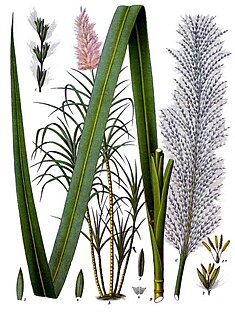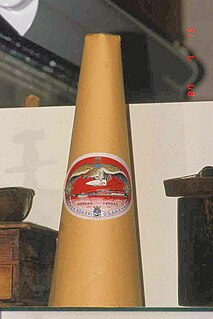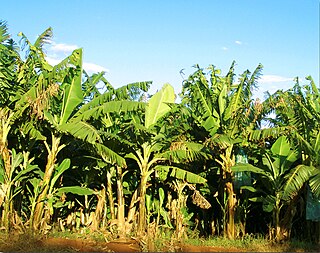Related Research Articles

Crop rotation is the practice of growing a series of different types of crops in the same area across a sequence of growing seasons. It reduces reliance on one set of nutrients, pest and weed pressure, and the probability of developing resistant pests and weeds.

Nutrient management is the science and practice directed to link soil, crop, weather, and hydrologic factors with cultural, irrigation, and soil and water conservation practices to achieve optimal nutrient use efficiency, crop yields, crop quality, and economic returns, while reducing off-site transport of nutrients (fertilizer) that may impact the environment. It involves matching a specific field soil, climate, and crop management conditions to rate, source, timing, and place of nutrient application.

Sugar plantations in the Caribbean were a major part of the economy of the islands in the 18th, 19th, and 20th centuries. Most Caribbean islands were covered with sugar cane fields and mills for refining the crop. The main source of labor, until the abolition of chattel slavery, was enslaved Africans. After the abolition of slavery, indentured laborers from India, China, Portugal and other places were brought to the Caribbean to work in the sugar industry. These plantations produced 80 to 90 percent of the sugar consumed in Western Europe, later supplanted by European-grown sugar beet.
A plantation economy is an economy based on agricultural mass production, usually of a few commodity crops, grown on large farms called plantations. Plantation economies rely on the export of cash crops as a source of income. Prominent crops included cotton, rubber, sugar cane, tobacco, figs, rice, kapok, sisal, and species in the genus Indigofera, used to produce indigo dye.

Engenho is a colonial-era Portuguese term for a sugar cane mill and the associated facilities. In Spanish-speaking countries such as Cuba and Puerto Rico, they are called ingenios. Both words mean engine. The word engenho usually only referred to the mill, but it could also describe the area as a whole including land, a mill, the people who farmed and who had a knowledge of sugar production, and a crop of sugar cane. A large estate was required because of the massive amount of labor needed to yield refined sugar, molasses, or rum from raw sugar cane. These estates were prevalent in Brazil, Cuba, Dominican Republic, and other countries in the Caribbean. Today, Brazil is still one of the world's major producers of sugar.

Sugarcane or sugar cane is a species of tall, perennial grass that is used for sugar production. The plants are 2–6 m (6–20 ft) tall with stout, jointed, fibrous stalks that are rich in sucrose, which accumulates in the stalk internodes. Sugarcanes belong to the grass family, Poaceae, an economically important flowering plant family that includes maize, wheat, rice, and sorghum, and many forage crops. It is native to the warm temperate and tropical regions of India, Southeast Asia, and New Guinea. The plant is also grown for biofuel production, especially in Brazil, as the canes can be used directly to produce ethyl alcohol (ethanol).
Ratooning is the agricultural practice of harvesting a monocot crop by cutting most of the above-ground portion but leaving the roots and the growing shoot apices intact so as to allow the plants to recover and produce a fresh crop in the next season. This practice is widely used in the cultivation of crops such as rice, sugarcane, banana, and pineapple. Ratoon crops cannot be perennially renewed, and may be harvested only for a few seasons, as a decline in yield tends to occur due to increased crowding, damage by pests and diseases, and decreasing soil fertility.

Sugar was first produced from sugarcane plants in India sometime after the first century AD. The derivation of the word "sugar" is thought to be from Sanskrit शर्करा (śarkarā), meaning "ground or candied sugar," originally "grit, gravel". Sanskrit literature from ancient India, written between 1500 - 500 BC provides the first documentation of the cultivation of sugar cane and of the manufacture of sugar in the Bengal region of the Indian subcontinent.

A banana plantation is a commercial agricultural facility found in tropical climates where bananas are grown.
The task system is a system of labor under slavery characteristic in the Americas. It is usually regarded as less brutal than other forms of slave labor. The other form, known as the gang system, was harsher. Under this system, each slave is assigned a specific task to complete for the day. After that task is finished, the slave is then free to do as he or she wishes with the remaining time. The gang systems forced the slaves to work until the owner said they were finished and allowed them almost no freedom. Whether plantation owners organized their slaves on the task or gang system had much to do with the type of crops they harvested. Tobacco and sugar cultivation was organized into gangs since those crops required considerable processing and supervision. Coffee, rice, and pimento were comparatively hardier plants where extensive supervision was unnecessary, leading planters to favor the task system on their plantations.
Proto-globalization or early modern globalization is a period of the history of globalization roughly spanning the years between 1600 and 1800, following the period of archaic globalization. First introduced by historians A. G. Hopkins and Christopher Bayly, the term describes the phase of increasing trade links and cultural exchange that characterized the period immediately preceding the advent of so-called "modern globalization" in the 19th century.
A slave plantation was an agricultural farm that used enslaved people for labour. The practice was abolished in most places during the 19th century.

A plantation complex in the Southern United States is the built environment that was common on agricultural plantations in the American South from the 17th into the 20th century. The complex included everything from the main residence down to the pens for livestock. Southern plantations were generally self-sufficient settlements that relied on the forced labor of enslaved people.
Costa Rican agriculture plays a profound part in the country's gross domestic product (GDP). It makes up about 6.5% of Costa Rica's GDP, and 14% of the labor force. Depending upon location and altitude, many regions differ in agricultural crops and techniques. The main exports include: bananas, pineapples, coffee, sugar, rice, vegetables, tropical fruits, ornamental plants, corn, potatoes and palm oil.
Black Barbadians or African Barbadians are Barbadians of entirely or predominantly African descent.

Neustanthus is a monotypic genus of flowering plants belonging to the pea family Fabaceae and its tribe Phaseoleae. The only species is Neustanthus phaseoloides, called tropical kudzu. This species is a forage crop and cover crop used in the tropics. It is known as puero in Australia and tropical kudzu in most tropical regions.

The planter class, known alternatively in the United States as the Southern aristocracy, was a racial and socio-economic caste of pan-American society that dominated 17th- and 18th-century agricultural markets. The Atlantic slave trade permitted planters access to inexpensive African slave labor for the planting and harvesting of crops such as tobacco, cotton, indigo, coffee, tea, cocoa, sugar cane, sisal, oil seeds, oil palms, hemp, rubber trees, and fruits. Planters were considered part of the American gentry.

Fairymead Sugar Plantation was a sugar plantation in Fairymead, Bundaberg Region, Queensland, Australia. It was established by Ernest Young together with his father Henry and brothers Arthur, and Horace. It was one of Bundaberg's earliest independent sugar plantations and had one of its earliest sugar mills.
The sugar industry of the United States produces sugarcane and sugar beets, operates sugar refineries, and produces and markets refined sugars, sugar-sweetened goods, and other products. The United States is among the world's largest sugar producers. Unlike most other sugar producing countries, the United States has both large and well-developed sugarcane and sugar beet industries. Refined sugarcane, processed sugar beet, and high-fructose corn syrup are all commonly used in the U.S. as added sugars to sweeten food and beverages.
This glossary of agriculture is a list of definitions of terms and concepts used in agriculture, its sub-disciplines, and related fields. For other glossaries relevant to agricultural science, see Glossary of biology, Glossary of ecology, Glossary of environmental science, and Glossary of botany.
References
- Abbott, Elizabeth (2009) [2008]. Sugar: A Bittersweet History, pages 83–87. New York: The Overlook Press. ISBN 978-1-59020-297-5.
- Parker, Matthew (2011). The Sugar Barons Walker Books. ISBN 978-0802717443